Royal Commercial Travellers' Schools, Pinner, Middlesex
The Royal Commercial Travellers' Schools were founded by John Robert Cuffley, himself a commercial traveller, to house and educate the children of those in his profession who met an untimely death or became unable to earn their living. After a meeting with some fellow travellers in July 1845, Cuffley set about raising funds for the scheme. A year later, the sum of £6,000 had been raised, and a general meeting of subscribers was held on June 29th, 1846. The meeting passed two resolutions. First, that the institution should be called 'The Commercial Travellers' School'. Second, that the object of the School was to be 'the Clothing, Maintaining, and Educating of Orphans and Children of necessitous Commercial Travellers'. The charity was managed by a board, consisting of three permanent trustees, a treasurer, and 36 members annually elected by subscribers.
The School's first premises on George Lane (now Eastern Avenue and Nutter Lane), Wanstead, were opened in August 1847. The property, a large house with extensive wooded grounds, could house over 100 children, although the funds available restricted the initial intake to twenty. The first children to be admitted were: Harry Bodill, from Liverpool, aged 7; Frederick Cooper, Colchester, 9; , Sarah Cruse, Warminster, 5; Alice Goddard, Shacklewell, 9; Elizabeth Herring, Gainsborough, 9; John Arthur James, Isle of Wright, 8½; Alfred Georg Jeremy, Great Yarmouth, 10; John Puntis Larner, Woolwich, 8; Fanny Manett Pearce, Evesham, 7½; Harry Walker Pettit, Stoke Newington, 7; William Pheasant, York Place, City Road, 8; Richard Dixey Scrivener, South Place, Kennington, 10; Horatio Thurston, St Helier's, Jersey, 9; Alfred Weatherill, York, 10½; Frederick Lloyd Williams Williams, Liverpool, 10; William Standfield, Sheffield, 7; Clarissa Copplestone, Hackney Road, 8; William George Toft, Bell's Buildings, Fleet Street, 8; Edward Moore, Halstead, 7; and John James Wagner, Bloomsbury Square, 10.
The School was officially opened on August 2nd, 1847, with the proceedings being reported in the press:
Several members of the Board of Directors, and other subscribers, met in Rood-lane, London, (at the house of Mr. Phillips, one of the Vice-Presidents), for the purpose of receiving the children (fifteen boys and five girls) and their friends from different parts of the country and the metropolis, preparatory to the former undergoing an examination by the medical officers. At ten o'clock Mr. Carey, the house surgeon, and Mr. Charles Ray, the consulting surgeon, entered upon the examination, and were engaged until half-past eleven, when the children were passed, and were immediately clothed in the dresses of the institution, when each one received from Mr. Phillips (the kind host) a glass of wine and a bun. The boys' dresses consist of black cloth cap, blue jacket, and vest, dark Oxford mixture trousers, and good linen under-clothing. The girls' dresses are of very pretty brown merino, with capes and sleeves, plain straw bonnet, smart ribbon, neat shoes, and white Stockings. The clothing is throughout of good quality, and of a truly respectable appearance, not having the remotest air of charity costume. About half-past one o'clock the children and their friends were conveyed in omnibuses to the institution at Wanstead, where they appeared delighted with the place and its arrangements. Many of the committee and subscribers were also at the institution, the number present amounting to about 50, exclusive of the pupils. Dinner was prepared for the latter and their parents, or other friends, who expressed themselves thankful for the comforts provided for their children, and delighted at the prospects in view for them. Several subscriptions were handed in during the day. The parents of the children left the institution at six o'clock, and the subscribers shortly afterwards.

Commercial Travellers' Schools, Wanstead, 1847Commercial Travellers' Schools, Wanstead, 1847. © Peter Higginbotham
Growing demand for places at the School, coupled with continued successful fund-raising, led to plans for a much larger purpose-built home for the institution. A suitable site was found on the Uxbridge Road at Hatch End, two miles to the north-east of Pinner, and the new School's foundation stone was laid by Prince Albert on 20th July, 1853. It was completed two years later and was officially opened, again by Prince Albert, on 27th October, 1855. The Elizabethan-style building, whose construction had cost in the region of £20,000, was designed by Messrs. Lane and Ardish. It could house up to 300 children.
The map below shows the location and layout of the Schools in around 1896. The main building lies towards the west of the site. By this date it had been extended at its north-western end.
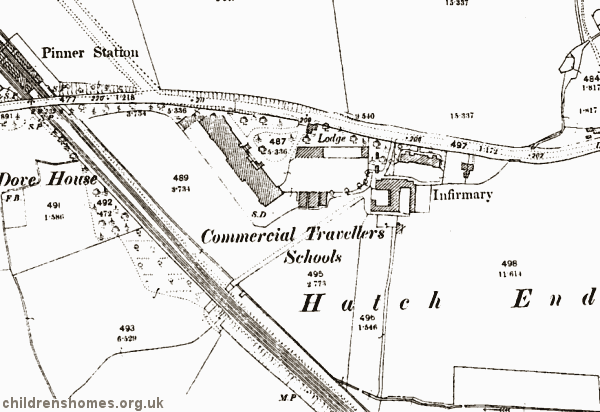
Commercial Travellers' Schools site, Pinner, c.1896.
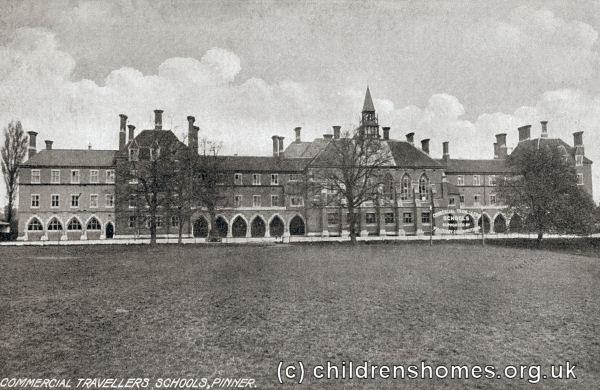
Commercial Travellers' Schools, main building from the west, c.1905. © Peter Higginbotham
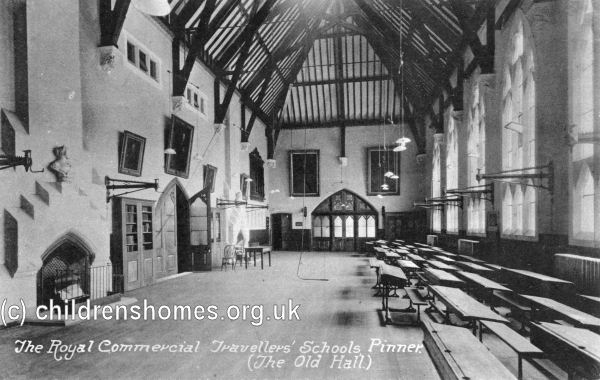
Commercial Travellers' Schools, old hall, 1920s. © Peter Higginbotham
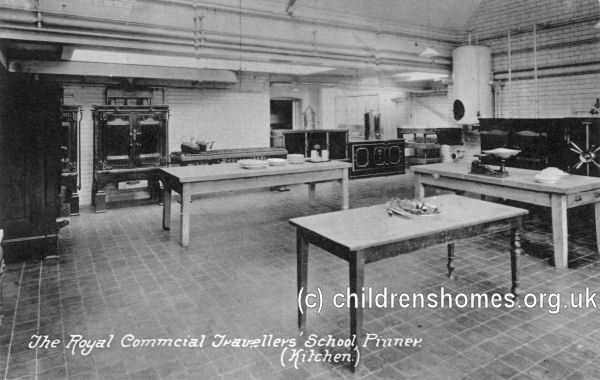
Commercial Travellers' Schools, kitchen, 1920s. © Peter Higginbotham
In 1878, several extensions were made to the buildings in memory of Mr George Moore, a well-known philanthropist who had been the charity's Treasurer. The additions, designed by Thomas Edward Knightley, comprised a two-storey infirmary (with a bust of Moore above its door), a large laundry, a swimming bath, and new dormitories in the main building.

Commercial Travellers' Schools, new infirmary, 1878. © Peter Higginbotham

Former Commercial Travellers' Schools, Pinner, Infirmary from the north-west, 2014. © Peter Higginbotham

Former Commercial Travellers' Schools, Pinner, Infirmary, 2014. © Peter Higginbotham
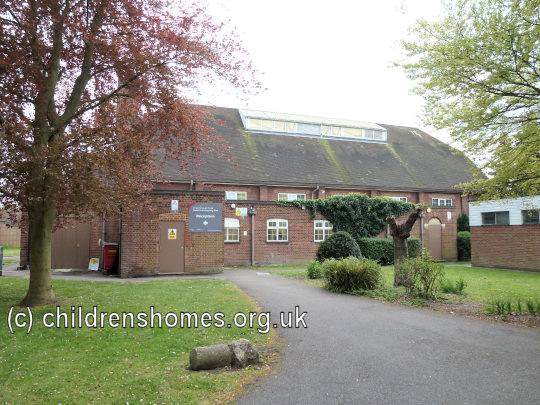
Former Commercial Travellers' Schools, Pinner, swimming pool, 2014. © Peter Higginbotham

Commercial Travellers' Schools dormitory, Pinner, c.1905. © Peter Higginbotham
Up until 1923, admission to the Schools was normally by means of an election in which subscribers to the charity voted for their choice of children on the list of applicants. By 1890, admission could also purchased by a one-off payment of 120 guineas. The eligibility criteria for admission also evolved over the years. Originally, applicants had to be 'destitute orphans of deceased, or children of necessitous, commercial travellers'. By the early 1900s, this was qualified as 'children of commercial travellers who have travelled for two years, either in town or country, and who are dead or in an unsound state of mind or body'. Candidates for admission had to be approved by the Schools' medical officer and were required to supply proof of their age, health, and parents' marriage, as well as a guarantee of eventual removal. Children of subscribers could be admitted between the ages of 5 and 10 (or from 7 for non-subscribers). Boys remained in the institution until their fifteenth birthday, then were assisted in finding situations. Girls remained until the age of sixteen.
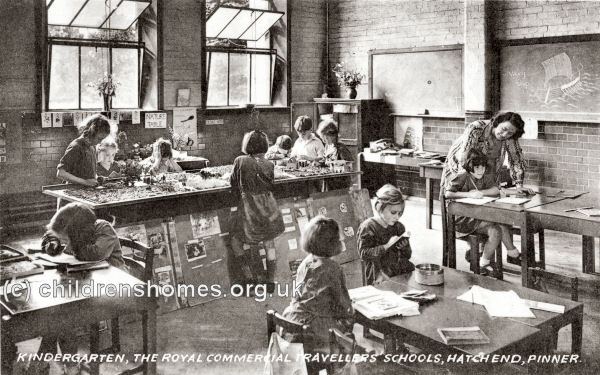
Commercial Travellers' Schools, Pinner, Kindergarten, early 1900s. © Peter Higginbotham

Commercial Travellers' Schools, Pinner, sewing class, early 1900s. © Peter Higginbotham
In 1905, a large new building, the 'B.G. Elliott Hall', designed by H.O. Cresswell, was erected at the east of the main block. It was opened by Mr (later Sir) Bignell Elliott, a former scholar of the institution.
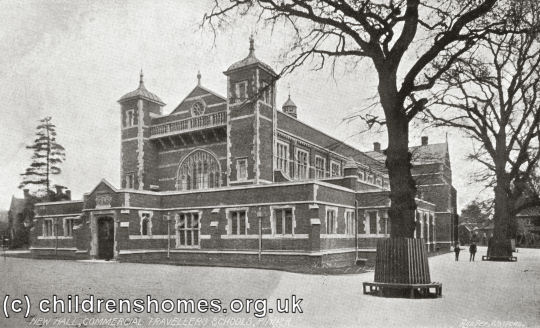
Commercial Travellers' Schools, Pinner, Elliott Hall from the south-west, c.1905. © Peter Higginbotham
The location of the new hall can be seen on the 1935 map below.
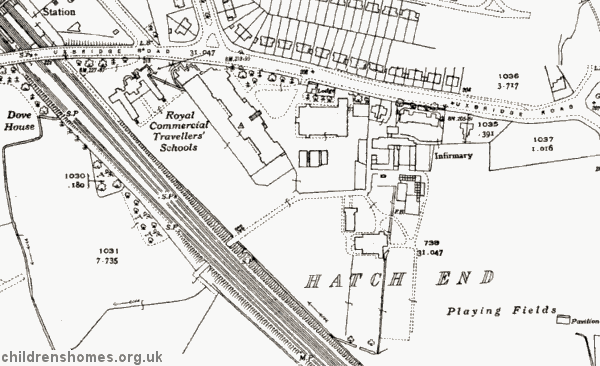
Commercial Travellers' Schools site, Pinner, c.1935.
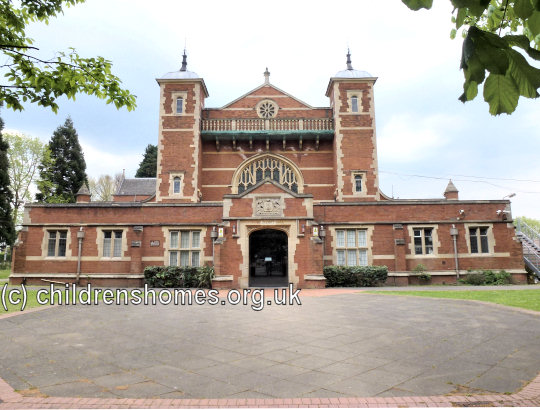
Former Commercial Travellers' Schools, Pinner, Elliott Hall from the west, 2014. © Peter Higginbotham

Former Commercial Travellers' Schools, Pinner, Elliott Hall from the north-east, 2014. © Peter Higginbotham
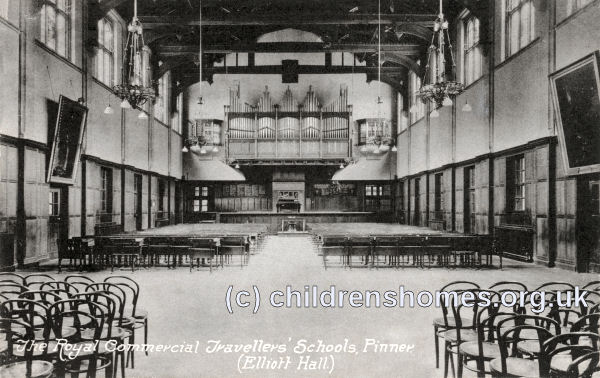
Commercial Travellers' Schools, Pinner, Elliott Hall interior, 1920s. © Peter Higginbotham
In 1918, King George V granted the institution the right to use the prefix 'Royal' in its name.
In the 1920s, 'Junior House' was erected at the west side of the main building.

Junior House, Commercial Travellers' Schools, Pinner, 1920s. © Peter Higginbotham
The boys received a 'commercial' education, which included a good grounding in mental arithmetic, algebra, fractions, mensuration (calculation of lengths, areas, volumes etc.) and a little French and Latin. As well as the usual classroom subjects, the girls were taught sewing, to make their own dresses, and a knowledge of housekeeping and cookery.

Travellers' Schools, Pinner, kitchen, 1920s. © Peter Higginbotham

Commercial Travellers' Schools, Pinner, domestic science class, 1920s. © Peter Higginbotham
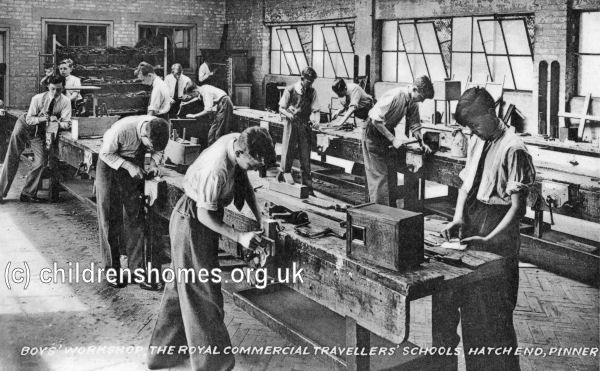
Commercial Travellers' Schools, Pinner, boys' workshop, 1920s. © Peter Higginbotham
Physical, as well as academic, education was much in evidence at the Schools. Girls, as well as boys, did gymnastics in the gymnasium, swimming, athletics, hockey, and performed outdoor drill exercises. A boys' wind band was also established.

Former Commercial Travellers' Schools, Pinner, gymnasium, 2014. © Peter Higginbotham
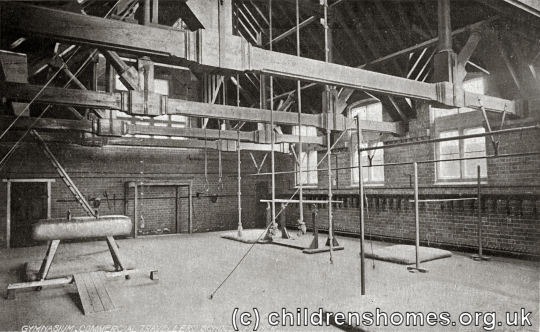
Commercial Travellers' Schools gymnasium interior, Pinner, c.1905. © Peter Higginbotham
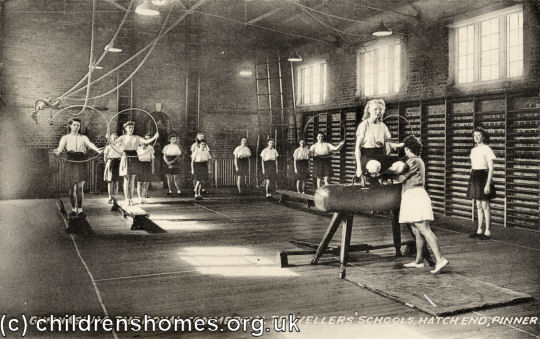
Commercial Travellers' Schools, Pinner, girls' gymnastics, c.1905. © Peter Higginbotham
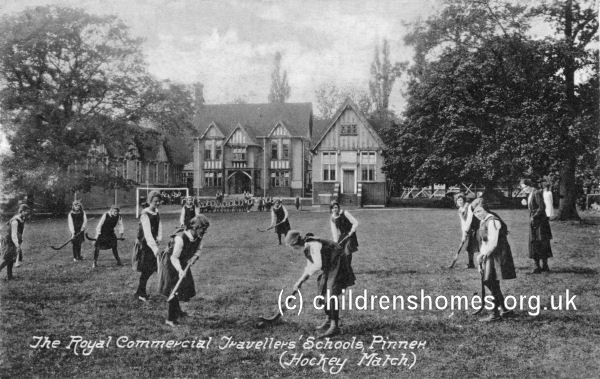
Commercial Travellers' Schools, Pinner, hockey match, 1920s. © Peter Higginbotham
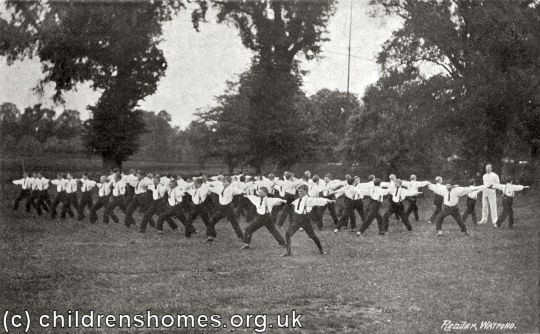
Commercial Travellers' Schools, Pinner, boys; drill c.1905. © Peter Higginbotham
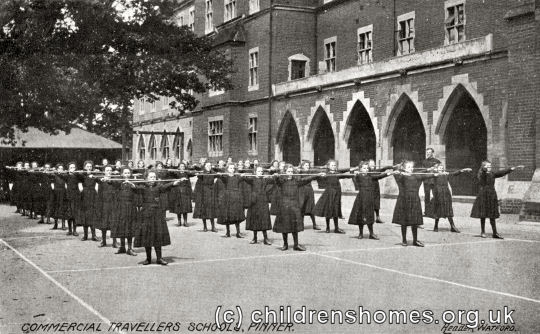
Commercial Travellers' Schools, Pinner, girls' drill c.1905. © Peter Higginbotham
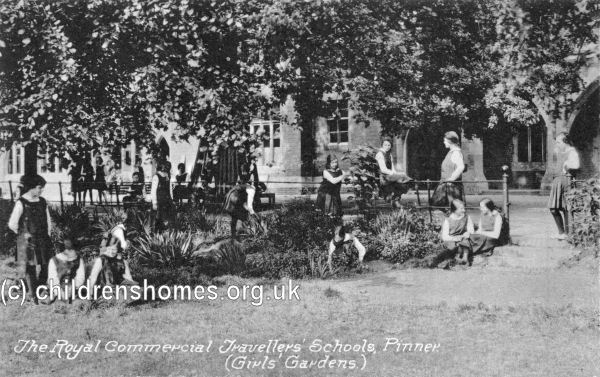
Commercial Travellers' Schools, Pinner, girls' garden, 1920s. © Peter Higginbotham
Rifle shooting also featured among the boys activities.
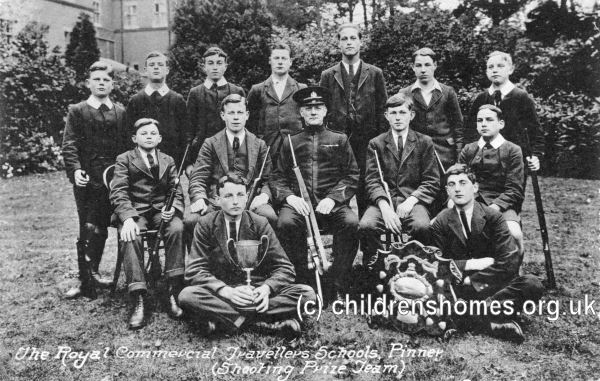
Commercial Travellers' Schools, Pinner, boys' rifle shooting team, 1920s. © Peter Higginbotham
The Schools, renamed the Royal Pinner School in 1965, closed two years later, having been home to more than 5,000 children in their 122-year history. From 1967 to 1987 the Elliot Hall building was occupied by the Harrow College of Further Education.
The main block was demolished by 1978 and its site is now occupied by a supermarket. Other buildings, including the Elliott Hall, Moore infirmary and swimming pool still survive, now used as local community facilities. The Harrow Arts Centre now occupies the Elliott Hall
Records
Note: many repositories impose a closure period of up to 100 years for records identifying individuals. Before travelling a long distance, always check that the records you want to consult will be available.
- The
Ancestry UK
website has two collections of London workhouse records (both name searchable):
- The Find My Past website has workhouse / poor law records for Westminster.
- London Metropolitan Archives, 40 Northampton Road, London EC1R OHB. Holds the Schools' extensive records including complete registers of all the children admitted. Details recorded include: the name, address and age of the child, name and address of sureties and nominator, date of election, details of parents, circumstances of remaining parent and/or family, date of expiry of school term, remarks on subsequent progress and career.
Census
Bibliography
- Keeling, Dennis F. Orphans of Commerce: The Commercial Travellers' Schools at Wanstead (1992, Tylney Press, Wanstead)
Links
- The Royal Commercial Travellers' Schools — website for former RCTS children ('Old Mercurians').
Except where indicated, this page () © Peter Higginbotham. Contents may not be reproduced without permission.


